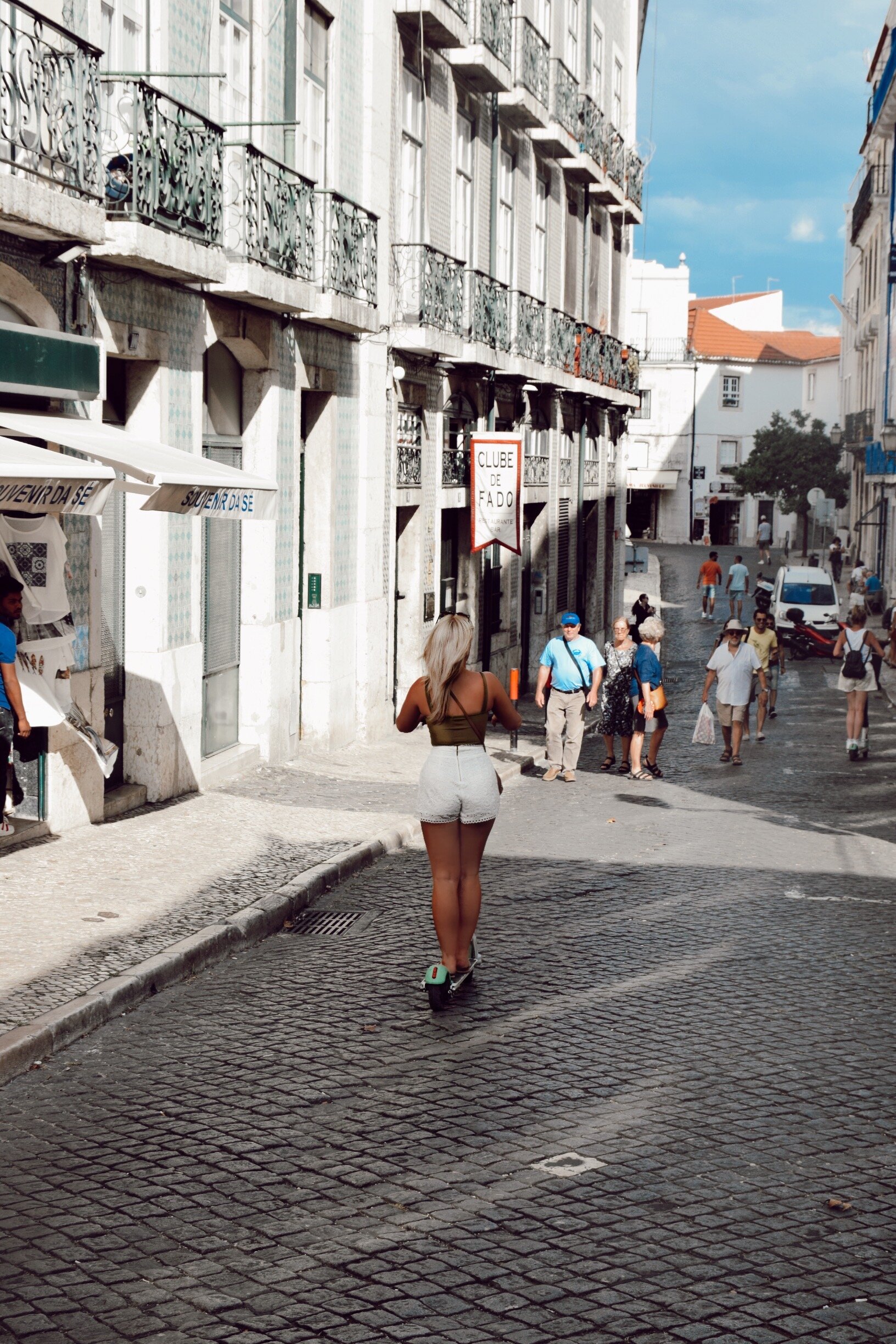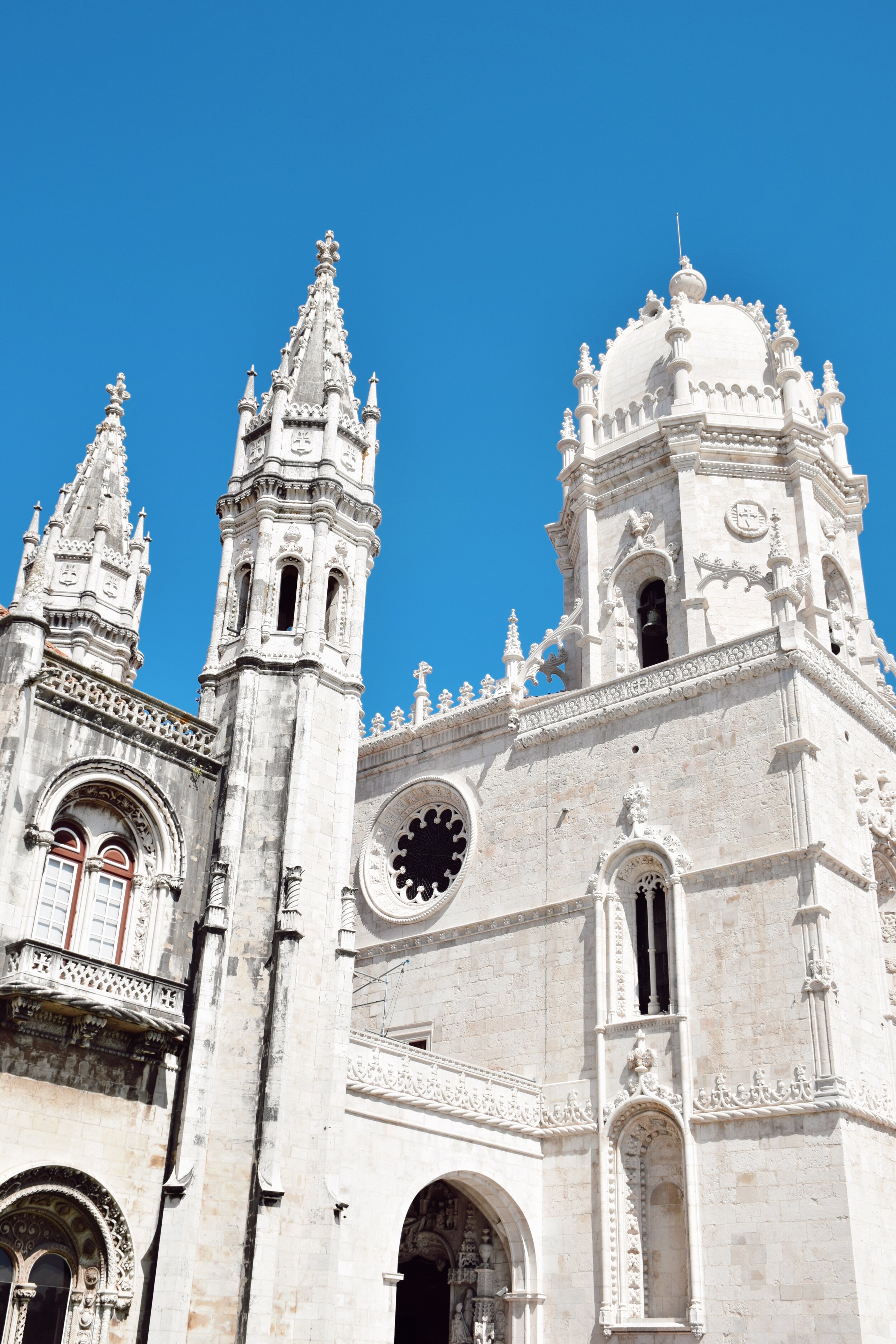A Long Weekend in Lisbon

I fell in love with Lisbon from the off. It’s filled with postcard-perfect cobbled alleyways, shabby-chic glamour, glossy tiled facades and is the Queen of tarts.
As mainland Europe’s westernmost capital, Lisbon is an enthralling place to spend a weekend thanks to its waterfront location, ancient ruins and white-domed Cathedrals. The city has managed to embrace change without casting aside its much-loved heritage, as it effortlessly entwines a modern vibrancy with a place-that-time forgot atmosphere.
We spent a long weekend here in September, where I was reunited with my Aunt and Uncle after having not seen them for 18 months. We spent the weekend together exploring Lisbon’s famous attractions, admiring colourful murals and tiled houses, all the while nibbling on irresistible pastéis de nata (custard tarts).
A long weekend in Lisbon is just enough time to appreciate the city’s architecture, discover the historical castles and palaces, take in the breezy sea views and immerse yourself in the sophisticated dining scene. The relatively compact size of the city means you’re able to pack a lot into a short break. Read on for my guide to Lisbon, which includes recommendations for what Lisbon has to offer.
AT A GLANCE
The best time to visit: March through October, when temperatures are warmer.
Getting Around: Bolt is new to Lisbon, Uber is also available, otherwise you can rely on trams, trains, and buses. We did a hop-on-hop-off tour which I would highly recommend doing when you are sticking to a time frame.
Currency: Euro.
Language: The language spoken in Lisbon is Portuguese but English is widely spoken by all people who work within the tourist industry.
EXPERIENCES
ALFAMA & BAIRRO ALTO
In Moorish times this was an upper-class residential area. After earthquakes brought down many of its mansions (and post-Moorish churches) it reverted to a working-class, fisher-folk quarter. It was one of the few districts to ride out the 1755 earthquake. Both districts are the older parts of Lisbon and feature narrow lanes of tiled buildings and have a distinct village atmosphere; you can quickly feel like an intruder if you take a wrong turn into someone's backyard. We rode electric scooters around these districts, which, in hindsight, was not an ingenious option to tackle the steep cobblestone streets, but it was memorable nevertheless.
We wandered Alfama until we came across the stunning viewpoint, Miradouro das Portas do Sol, just in time for sunset. Despite the swarms of tourists photographing the sea of red rooftops; I could have stayed there all evening. It had a dynamic yet romantic atmosphere, with impromptu dancing, live music and plenty of bars to choose from.
BELEM
Just a short trip along the riverside to the west of Lisbon, sits the district of Belém (pronounced ber-layng). Rich in its maritime history, Belém lies along the Tagus River and contains some of the capital’s most grandiose nautical monuments. It was from here that Vasco da Gama set off for India in 1497, and the vast Mosteiro dos Jerónimos was built to honour his safe return, along with the landmark Torre de Belém, which was built as part of a series of fortifications designed to protect the natural port of Lisbon. I strongly advise that you make the trip here early in the day to avoid the queues and tourists. You can either take a train from Cais dos Sodre station, or take the electric tram (number 15). We opted rather to do the hop-on-hop-off bus tour for a day, which conveniently dropped us down in Belém.
You simply can’t visit Lisbon without tasting their famous pastéis de nata. These mouth-watering treats have a flaky outside and melt-in-your-mouth custard inside. The original Pastel de Nata pastries come from the patisserie, Pasteis de Belem and they supposedly still make the best in town. So you’re pretty much obligated to make a pit stop here to determine for yourself whether this is true. Do yourself a favour and don’t wait in the queues for takeaway – head straight for table service.
SINTRA
In case you haven’t noticed, social media is in a complete frenzy over Sintra. This extraordinary aristocratic hillside town is a Neverland of fairy-tale palaces, manicured gardens and wild forests - it warrants at least a day of your itinerary (although 2 days would allow you to make the most of Sintra town and it’s glorious surroundings). Sintra is a short and cheap drive or train ride inland from Lisbon. In fact, we chose to Bolt it there early one morning for a total of 16 Euros. If you’d prefer to take the train, it’s a 40-minute journey and costs €2.25 for a one-way ticket.
This UNESCO world heritage-listed centre, Sintra-Vila, is dotted with pastel-hued manors folded into luxuriant hills that roll all the way down to the blue coast of the Atlantic. Sintra enjoys a cool mountainside location and was hugely popular among Portugal’s royals; apparent by their ornate and extravagant palaces. Palácio da Pena (Pena Palace) is the most decadent and well-known Castle within Pena Park, and is composed of two wings: the monastery and the new palace. The architectural style is different from other Castles, as it is a mix of several styles such as Neo-Gothic, Neo-Manueline, Neo-Islamic and Neo-Renaissance. Pena and the Park are Portugal’s greatest example of Romanticism. The whole structure will leave you in awe.
Often disregarded, Montserrate is one of the more unique palaces in the region. It blends a series of gothic, Arabic, and Indian architecture together; despite having been commissioned by an Englishman. The views of the rolling hills from this Castle are stunning, and the intricate designs along the interior and exterior are exquisite. In general, it’s smaller and less crowded than the other Castles. All of this is highly scenic, though be warned, the summer crowds can utterly swamp Sintra’s narrow streets, so once you’ve seen the sights, you’re best off heading to the surrounding attractions up in the hills or down along the coast.
Note: Regardless of how you get to Sintra, you will be doing a lot of walking. Make sure you wear comfortable flat shoes. Purchase your tickets for the Park online and in advance to benefit from the discount.
CASCAIS
A coastal resort town to the Northwest of Lisbon and south of Sintra, Cascais (kush-kaish) was once regarded as a sleepy fishing village, and has developed into a much-loved summertime playground. Easily accessible from Lisbon city and Sintra, it’s a popular spot for weekend holidays and is known for its beautiful beaches and lively marina. We drove south down through the hills of Sintra to have an afternoon by the seaside. Having lived in London for the last 18 months, we were in dire need of basking in the sunshine and dipping our toes in the ice-cold Atlantic while we had the opportunity.
WHERE TO STAY
Lisbon’s most famous neighbourhoods are Baixa (‘downtown’) and Chiado (the shopping district). Bairro Alto and Alfama are the older districts of Lisbon, with steep streets and tiled buildings. Both areas are picturesque yet crowded, as they attract tourists and vibrant nightlife. When considering options for accommodation, decide if you want to be in a quieter part of town and if you don’t mind the hills and vibrancy of Bairro Alto and Alfama. If that doesn’t deter you, you’re in for a real treat - the benefit of staying in these areas are the magnificent views, not to mention being in the centre of Lisbon’s night life.
We spent the weekend in the heart of Bairro Alto, at the newly renovated 5-star Bairro Alto Hotel. A member of the Leading Hotels of the World, this boutique Hotel overlooks the Praça Luis de Camões, Lisbon’s main square, and is home to a sensational roof-top bar with wonderful views of the Atlantic and Lisbon’s surroundings.























